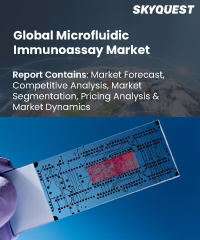
Product ID: SQMIG35H2075

Report ID:
SQMIG35H2075 |
Region:
Global |
Published Date: February, 2024
Pages:
157
|
Tables:
36 |
Figures:
74
Microfluidic Immunoassay Market size was valued at USD 25597.94 million in 2019 and is poised to grow from USD 28718.33 million in 2023 to USD 71897.42 million by 2031, growing at a CAGR of 12.19% in the forecast period (2024-2031).
The microfluidic immunoassay market is expanding quickly and has the potential to improve patient care in situations with limited resources. POC tests are carried out in hospitals, ambulatory care facilities, doctor's offices, or even at the patients' homes. The demographic shift and demand for cost-effective, high throughput diagnosis are driving the POC industry's rapid growth. However, a lot of the current POC devices require sample pre-treatment before testing, yield inconsistent results, and provide subpar quantitative, qualitative, or qualitative and semi-quantitative test results. This prompted the downsizing of POC devices and a growing emphasis on delivering precise and quantitative results. A lot of interest has been paid to microfluidic systems (lab-on-a-chip) as a platform for miniature immunodiagnostics. Small amounts of reagents and samples are consumed, and exact findings are delivered quickly, as two major benefits of LOC.
The Microfluidic Immunoassay market is growing due to the larger benefits offered by LOC over conventional measurable methods, the growing need for POC in low-resource settings, increased research efforts in the field of microfluidic technology, a high intake of venture capital financing for the development of LOC-based POC diagnostics, rapid decision making employing POC diagnostics technologies in emergency care, and the rising incidence and prevalence of chronic diseases integrated with aging population across the globe.
US Microfluidic Immunoassay Market is poised to grow at a sustainable CAGR for the next forecast year.
Our industry expert will work with you to provide you with customized data in a short amount of time.
REQUEST FREE CUSTOMIZATIONMicrofluidic Immunoassay Market size was valued at USD 25597.94 million in 2019 and is poised to grow from USD 28718.33 million in 2023 to USD 71897.42 million by 2031, growing at a CAGR of 12.19% in the forecast period (2024-2031).
Want to customize this report? This report can be personalized according to your needs. Our analysts and industry experts will work directly with you to understand your requirements and provide you with customized data in a short amount of time. We offer $1000 worth of FREE customization at the time of purchase.

Product ID: SQMIG35H2075